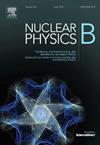广义Riemann-Hilbert-Birkhoff分解与一类新的高阶可积层次
IF 2.8
3区 物理与天体物理
Q2 PHYSICS, PARTICLES & FIELDS
引用次数: 0
摘要
我们提出了一种广义的Riemann-Hilbert-Birkhoff分解,它从两个基本方面扩展了标准的可积层次形式:与传统模型相比,它允许流动方程中Lax矩阵分量的整数幂增加,并且它包含恒定的非零真空(背景)解。另外两个参数控制这些特性。第一个定义了支撑层次结构代数构造的半简单元素的等级,其中一级半简单元素恢复已知的层次结构,如mKdV和AKNS。第二个参数区分零和非零常数背景(真空)配置。此外,我们还引入了第三个参数,该参数与修整矩阵的零级分量的定义中的模糊性有关。虽然不影响分解本身,但该参数对可积方程的不同规范实现进行分类(例如,kap - newell, Gerdjikov-Ivanov, Chen-Lee-Liu模型)。对于这些参数的不同取值,我们以统一的通用方式构造并分析了相应的可积模型,证明了扩展形式论的广泛适用性和生成能力。本文章由计算机程序翻译,如有差异,请以英文原文为准。
Generalized Riemann-Hilbert-Birkhoff decomposition and a new class of higher grading integrable hierarchies
We propose a generalized Riemann-Hilbert-Birkhoff decomposition that expands the standard integrable hierarchy formalism in two fundamental ways: it allows for integer powers of Lax matrix components in the flow equations to be increased as compared to conventional models, and it incorporates constant non-zero vacuum (background) solutions.
Two additional parameters control these features. The first one defines the grade of a semisimple element that underpins the algebraic construction of the hierarchy, where a grade-one semi-simple element recovers known hierarchies such as mKdV and AKNS. The second parameter distinguishes between zero and non-zero constant background (vacuum) configurations.
Additionally, we introduce a third parameter associated with an ambiguity in the definition of the grade-zero component of the dressing matrices. While not affecting the decomposition itself, this parameter classifies different gauge realizations of the integrable equations (like for example, Kaup-Newell, Gerdjikov-Ivanov, Chen-Lee-Liu models).
For various values of these parameters, we construct and analyze corresponding integrable models in a unified universal manner demonstrating the broad applicability and generative power of the extended formalism.
求助全文
通过发布文献求助,成功后即可免费获取论文全文。
去求助
来源期刊

Nuclear Physics B
物理-物理:粒子与场物理
CiteScore
5.50
自引率
7.10%
发文量
302
审稿时长
1 months
期刊介绍:
Nuclear Physics B focuses on the domain of high energy physics, quantum field theory, statistical systems, and mathematical physics, and includes four main sections: high energy physics - phenomenology, high energy physics - theory, high energy physics - experiment, and quantum field theory, statistical systems, and mathematical physics. The emphasis is on original research papers (Frontiers Articles or Full Length Articles), but Review Articles are also welcome.
 求助内容:
求助内容: 应助结果提醒方式:
应助结果提醒方式:


